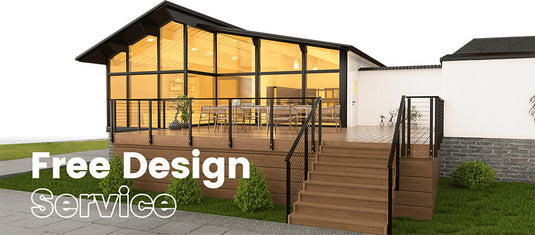Aluminum vs Composite Deck Railing: Which is Better?

When you're building or renovating a deck, the railing material you choose is crucial—it's not just a visual centerpiece but also a key safety feature. In the world of deck railings, aluminum and composite materials stand out as two popular contenders, each bringing a unique set of pros and cons to the table. Aluminum railings are celebrated for their durability, corrosion resistance, and ease of installation, while composite railings offer a wealth of color options and styles, along with impressive durability. Yet, both materials also carry potential drawbacks, from cost considerations to environmental impact. This article will explore these two top choices in deck railing materials, helping homeowners make an informed decision that balances aesthetics, functionality, and cost-efficiency for their outdoor spaces.
Aluminum Deck Railings
What Makes Aluminum Deck Railings a Strong Choice?

Aluminum deck railings are a popular pick for their toughness and low upkeep. They don't rust or corrode, which is great news whether you live in a rainy region or near the beach where salty air is common. They're also immune to the typical problems that can affect wood, like rot, warping, or bug damage.
Taking care of aluminum railings is pretty straightforward—they stay looking good with just a bit of soap and water. So, if spending your weekends staining or sealing a wooden railing doesn't sound appealing, aluminum could be the way to go. Plus, these railings won’t catch fire, giving you peace of mind.
Installing aluminum railings is often a smooth process thanks to their lightweight nature. Many come in easy-to-assemble kits that you can set up without needing to hire professionals or use fancy tools.
What Style Options Do Aluminum Railings Have?
Whether you’re after a modern, clean look or something more classic, aluminum railings have got you covered. They come in various designs and finishes—including powder-coated colors that last long and resist wear and tear. Although they might not get as hot in the creative color department as composites, there's usually a good enough selection to meet most tastes.
Are There Any Downsides to Aluminum Railings?
While aluminum railings have lots going for them, they're not perfect. They generally cost more upfront than wood, so they might not fit everyone's budget. If your deck gets a lot of sun, keep in mind that aluminum can heat up when it’s blazing outside. This means they could get uncomfortable to touch on really hot days. And while you do have some color choices, you might not find the same variety as you would with composite materials, which could be a bummer if you have a specific shade in mind for your deck.
Composite Deck Railings

How Do Composite Deck Railings Stand Out?
Composite deck railings are a favorite for those who want the wood look without the wood workload. These railings are made from a blend of wood fibers and plastics, which gives them the ability to fend off the weather, resist insects, and avoid rotting—issues that often affect traditional wood railings.
One of the biggest perks of composite railings is that they don't need much when it comes to maintenance. There's no sanding, staining, or sealing needed here. Just a simple cleanup with basic cleaning supplies will keep them looking sharp. And since they come in a variety of colors and textures, you can easily match them with your home’s style or even mimic the look of real wood.
They're also built to last. Composites are tough and typically come with warranties that promise many years of solid performance. This durability means you won’t be replacing your railing any time soon.
What Limitations Might You Face with Composite Deck Railings?
While composite railings have lots of advantages, there are a couple of things to consider before making your choice. For starters, they are usually more expensive than both wood and aluminum railings. If you're watching your wallet, this could be an important factor.
Because they are denser and heavier than aluminum, installing composite railings can be a bit more complex. You might need some extra muscle or help to get them into place, and sometimes additional structural support is necessary to ensure they’re secure.
Another point to note is that despite their resistance to weathering, some composites can fade over time due to continuous exposure to sunlight. They may also develop stains, so if you go for lighter colors, be ready for the possibility of more visible wear and tear.
How Do Aluminum and Composite Deck Railings Measure Up Against Each Other?
When choosing between aluminum and composite deck railings, it’s like picking between two great flavors of ice cream—each has its own appeal. To put it in perspective, let’s break down the main differences side by side in a table format so you can see which aspects might tip the scales for your particular deck situation.
| Feature | Aluminum Railings | Composite |
| Initial Cost | Typically lower than composite | Generally higher than aluminum |
| Maintenance | Low; occasional cleaning required | Low; occasional cleaning, may require more if light-colored |
| Durability | Resistant to rust and corrosion; does not warp or rot | Resilient to rotting, warping, and insect damage |
| Lifespan | Long-lasting with minimal fading | Durable; potential for some fading over time |
| Installation | Easier, lightweight; often suitable for DIY | Can be heavier, might need extra support during installation |
| Design Options | Variety of styles, but limited colors | Wide range of colors and textures |
| Heat Retention | Can become hot to touch in direct sunlight | Typically retains less heat than metal options |
| Environmental Impact | Recyclable materials | Often made from recycled wood and plastic components |
| Aesthetic | Sleek, modern appearance; mimics wrought iron | Mimics natural wood; extensive color options |
This table should give you a clearer picture of what each type of railing brings to your deck. Aluminum is cost-effective and cool when it comes to maintenance, while composite offers that natural look with a broader palette to play with. In terms of lasting power, both hold up well, though aluminum might stay looking the same a bit longer without the risk of fading.
Remember, while both types are solid choices for any deck, the best option for you will depend on various factors unique to your situation, such as climate, design preference, budget, and how much time you’re willing to dedicate to the upkeep of your deck.
What Should You Think About When Picking Aluminum or Composite Railings?

Choosing between aluminum and composite for your deck railing boils down to what matters most to you. Let's break it down into simple terms, so you can figure out which one fits your deck dreams without giving you a headache.
How Much Do You Want to Spend?
- Upfront Cost: Aluminum usually gives your wallet a break at the start compared to composite.
- Value Over Time: Don't just think about now—consider how long each option will last without needing a do-over.
How Much Elbow Grease Are You Willing to Put In?
- Keeping It Clean: Both are pretty low on the effort scale for cleaning, but some designs might ask for a bit more scrubbing.
- Your Free Time: If you'd rather relax than work on your deck, both materials win over wood that needs constant care.
How Will They Hold Up to Your Weather?
- Toughing It Out: Both can take on Mother Nature, but if your deck is a sun magnet, remember aluminum can get hot, while composites might fade a tad.
- Sunshine Factor: Sunny decks might make aluminum a touch too warm for comfort and cause some colors of composite to lose their sparkle over the years.
What’s Your Style?
- Looks: If you're after a woodsy vibe without real wood hassle, composites have got you covered with lots of color choices. Aluminum offers a modern flair and can mimic fancy ironwork.
- Matching Your Home: Got a specific look in mind? Composite gives you more colors and finishes to play matchmaker with your house.
Thinking Green?
- Eco-Friendly Pick: Both can be made from recycled stuff. If being kind to the planet tops your list, check how they're made before you choose.
Planning to DIY?
- Ease of Setup: Aluminum's lighter weight makes it friendlier for DIY installs. Composites are heavier, possibly needing more hands-on-deck or even a pro.
Balance what you care about with these practical points, and you'll land on the railing that not only looks great but also fits your lifestyle and home just right.
Wrapping It Up
Both aluminum and composite railings have great features. Aluminum scores points for strength, cost-effectiveness, and simpler installation, while composite wins hearts with its beauty and variety.
The best railing for you isn’t about what everyone else says is top-notch—it’s about what adds to your life and your deck in the best way. Weigh your personal wants, the demands of your deck space, and your long-term plans, and you’ll find the perfect match to complete your outdoor sanctuary.

Custom Design Solutions - Fast and Free
Our experts can do all the planning, designing, and budgeting work for you without extra charge.
● Customized Design
● Shopping List
● Budget
